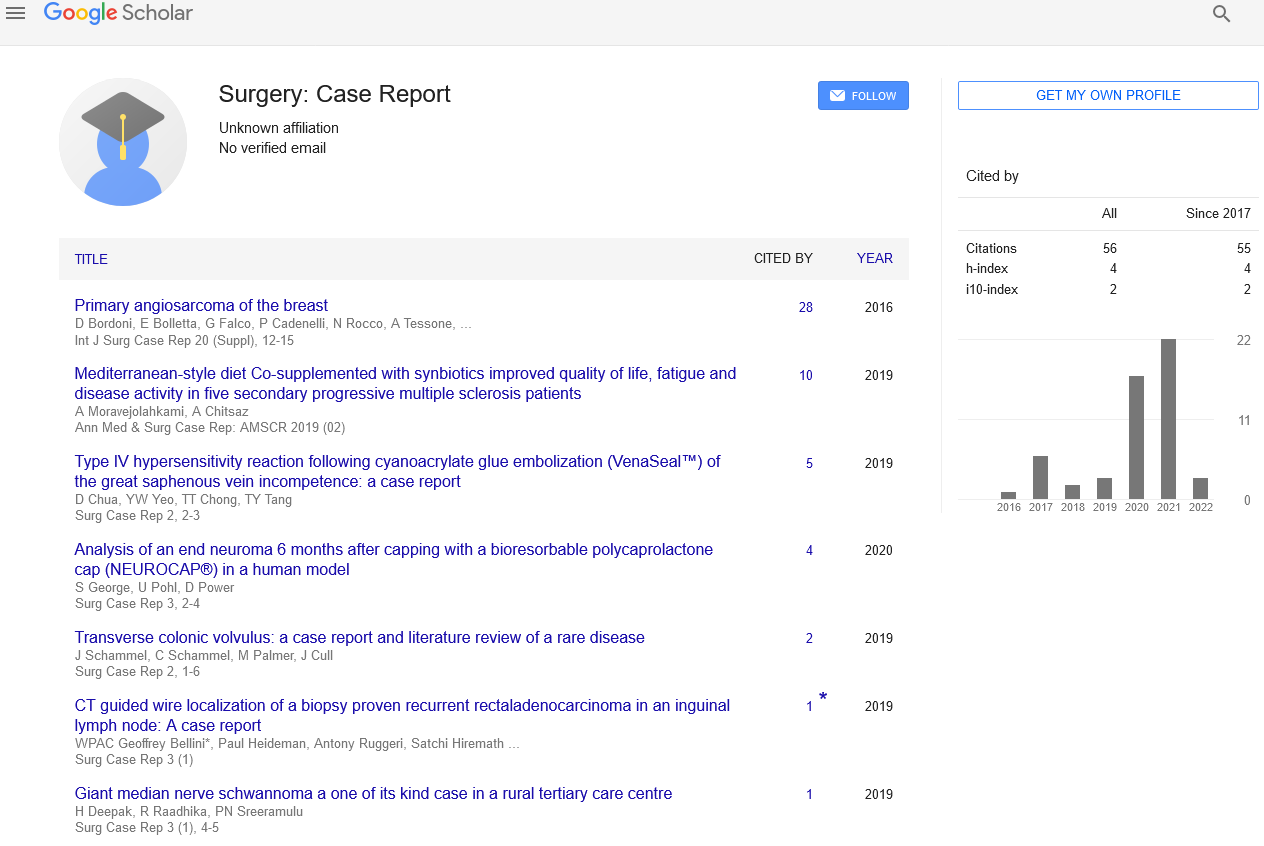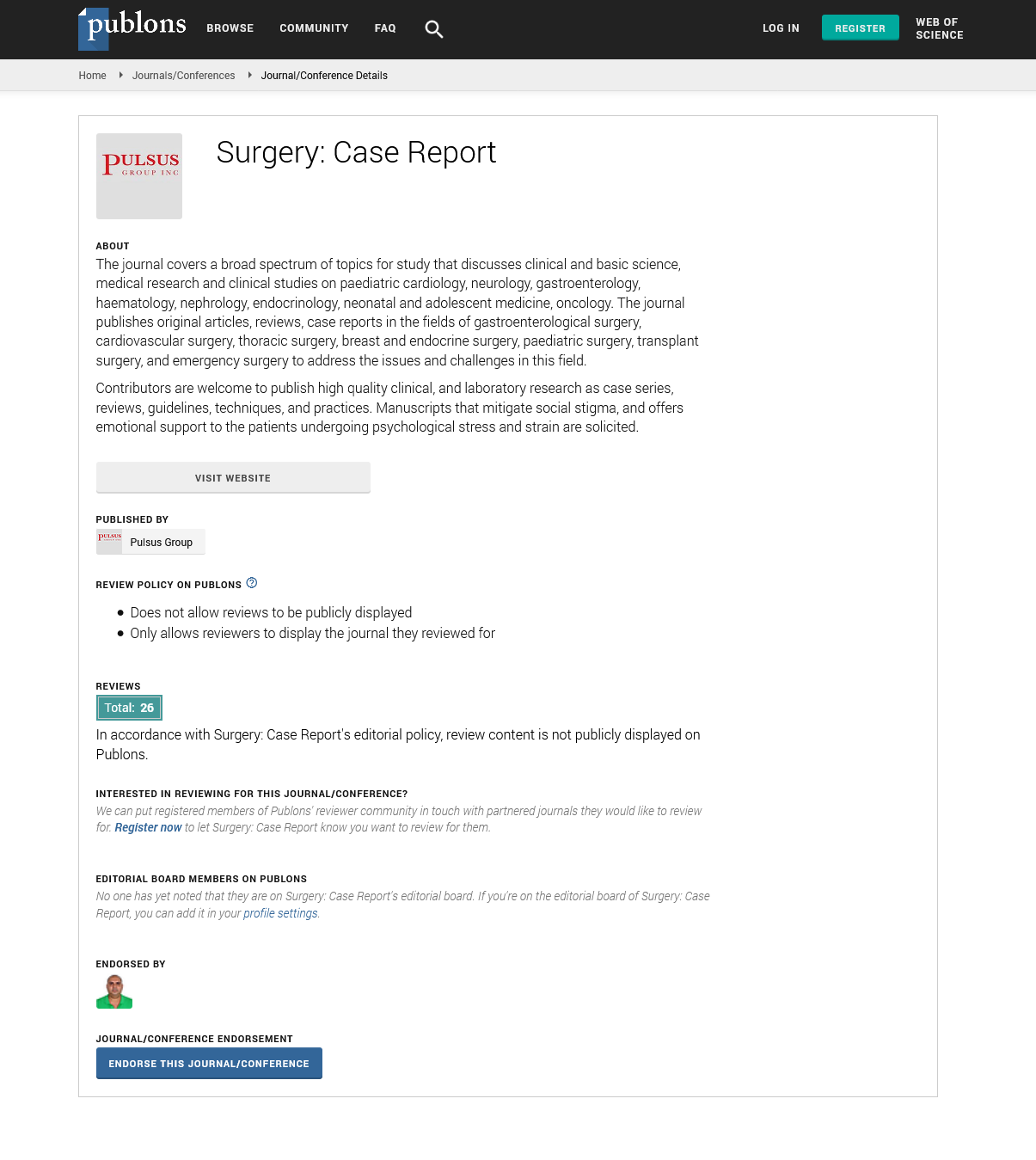Lymphatic microsurgery in the past
Received: 07-Jul-2021 Accepted Date: Jul 18, 2021; Published: 27-Jul-2021
Citation: Ajit SL. Lymphatic microsurgery in the past. Surg Case Rep. 2021;5(4): 5.
This open-access article is distributed under the terms of the Creative Commons Attribution Non-Commercial License (CC BY-NC) (http://creativecommons.org/licenses/by-nc/4.0/), which permits reuse, distribution and reproduction of the article, provided that the original work is properly cited and the reuse is restricted to noncommercial purposes. For commercial reuse, contact reprints@pulsus.com
Abstract
Lymphedema is normally treated conservatively, but surgery may be recommended in some circumstances. If you have chronic nonpitting edoema, suction assisted lipectomy (SAL), also referred as lymphedema liposuction, might aid. The operation involves the removal of fat and protein, as well as ongoing compression therapy. Although there is some proof to substantiate vascularized lymph node transfers (VLNT) and lymphovenous bypass, they are linked to a variety of problems.
Keywords
Lymphedema; Lymphatic system; Suction Assisted Lipectomy (SAL); Vascularized Lymph Node Transfers (VLNT); Lymphovenous bypass
Introduction
Lymphedema is a disorder in which the lymphatic system becomes clogged and causes localized swelling. The lymphatic system is an important part of the body’s immune system and is responsible for returning interstitial fluid to the bloodstream. Lymphedema is most commonly a side effect of cancer therapy or parasite infections, although it can also occur as a result of a variety of hereditary abnormalities. Despite the fact that the disease is incurable and progressing, there are a variety of treatments that can help alleviate symptoms. Since the lymphatic system has been damaged, lymphedema tissues would be at a significant risk of complications. Although there is no remedy, medication can help. Compression therapy, excellent skin care, exercise, and manual lymphatic drainage (MLD), sometimes known as combined decongestive therapy, are prominent examples. The usage of diuretics is ineffective. Surgery is usually reserved for patients who have failed to progress with other treatments.
Literature Review
Different approaches over time period
The lymphatic system has gotten modest consideration from a surgical standpoint for a long time. The anatomical and physiologic characteristics of this vascular system have found it challenging to research, comprehend, and operate with. The earliest surgical efforts to cure lymphedema were made in the early twentieth century, but they were discontinued due to poor outcomes and a high risk of mortality. Those surgical treatments, however, seemed theoretically sound and functioned as the seedbed for more current approaches.
The Charles treatment developed ablative surgical procedures in 1901, and they are still used today with contemporary liposuction techniques [1]. Yamada, the forerunner who invented the notion of lymphatic venous anastomosis in 1969, suggested a plastic surgery technique which is identical with lymph node transfer [2,3].
Nevertheless, it wasn’t until the early twenty-first century when research there in lymphatic system resurfaced, and plastic surgeons began looking for efficient lymphatic surgical methods. During the year 2000, Koshima pioneered the idea of super microsurgery, which involves the anastomosis of vessels with a caliber of 0.8 to 0.5 mm, establishing reconstructive microsurgery area and making lymphatic microsurgery possible. Technological advancements have aided significant development in the area [4]. The advancement of super microsurgery has relied heavily on high magnification microscopes, super microsurgical equipment, and diagnostic imaging approaches. In several ways, Indocyanine green (ICG)-lymphangiography (ICG-L) has replaced conventional lymphoscintigraphy as the most excellent clinical investigation for the lymphatic system [5]. The lymphatic system’s function can indeed be tested since an intradermal injection of ICG, and patients can choose between ablative and physiologic operations.
Understanding the physiology of lymphatic system function and malfunction is critical in order to deliver the best treatment for a patient. Histopathological alterations in lymphatic vessels are already recognized to develop when lymphedema progresses. It begins with ectasia or dilatation in the initial phases, then contraction in the middle stages, and finally sclerosis in the late stages [6]. This concept is significant because, while there are presently no therapies for lymphedema, early detection and care can help to reverse or ease the condition and reduce its devastating symptoms. Physiologic operations can be offered once a lymphatic system has some functionality. Only ablative surgery is indicated in situations with full degeneration or sclerosis [7]. Especially when combined, both procedures have demonstrated to be good, and in some situations, combining them yields even better results. The Barcelona Lymphedema Algorithm for Surgical Treatment of Lymphedema (BLAST) is a reasonable and straightforward approach to lymphedema surgery that provides tailored therapies by integrating various surgical approaches [8]. LVA and/or lymph node transplant may be administered to patients who have a functioning lymphatic system as determined by ICG-L. Patients with non - functional lymphatic systems and excess fat deposits are candidates for Brorson-based liposuction [9].
LVA is indeed a low-risk procedure that functions by diverting excessive lymph from such an inefficient lymphatic system into veins at the microcirculation level, bypassing sites of congestion. ICG-L is required for locating lymphatic vessels that transport lymph within the lumen. Magnetic resonance lymphangiography adds towards the data collected by ICG-L by delivering 3-dimensional pictures of the entire extremities as well as quantitatively as well as quantitatively data upon the functional lymphatic vessels [10]. Both evaluations can be done before surgery to evaluate where functional lymphatic vessels are located and where LVA should be performed. This procedure can be done in conjunction with vascularized lymph node transfer (VLNT).
The modes of action of VLNT are currently unknown, although there are two theories. It might either operate as an absorbent, absorbing lymphatic fluid and funneling it into the vascular system, or the transferred nodes could encourage lymphangiogenesis. The groyne remains the most preferred donor location since it generates a continuous free flap vascularized by the superficial circumflex iliac arteries while comprising the functionalization including its lymphatic system from capillaries to receptive lymphatics and nodes. To reduce the possibility of donor lower limb lymphedema, great care should always be used during collecting superficial inguinal lymph nodes. The lymph nodes in the lower limb are located and preserved using reverse lymphatic mapping with ICGL so that they’ll be avoided from the flap.
Different recipient sites are also detailed, with no agreement on the best location. However, in the case of lymphedema caused by surgery, trauma, or radiotherapy, a wide excision of the scar and other anatomically confined structures is necessary to guarantee a healthy bed for lymphangiogenesis. Decompressing the axillary vein, which might be an indirect consequence of lymphedema, seems to be particularly necessary in the upper extremity. A deep inferior epigastric perforator (DIEP) flap with lymph nodes might be supplied to patients who want a simultaneous breast reconstruction and lymphedema treatment. The DIEP flap, which is anastomosed to internal mammary vessels for breast reconstruction, and the superficial inguinal lymph node flap, which is anastomosed to thoracodorsal vessels for lymphedema treatment, is two examples of this method. During the same operation, patients with viable lymphatic veins in the upper extremity can indeed benefited from LVA.
Discussion
Given the enormous advancements in lymphatic microsurgery, there are still a few restrictions when it comes to treating lymphedema patients, and no definite treatment can be provided. The biggest drawback would be that lymphatic insufficiency is irreversible when lymphatic vessels show histologic signs of deterioration. While other channels to decompress the damaged extremities could be provided, overall lymphatic system cannot be restored, and perhaps some amount of shortage will indeed exist.
The right therapy for lymphedema patients currently involves a multidisciplinary strategy that includes counseling, conservative physical measures, and surgical intervention to relieve discomfort and improve health and wellbeing. Because of the limits of existing lymphedema treatments, low risky lymphedema surgery has emerged as a possible method of preventing lymphedema [11]. When axillary reverse mapping is combined with rapid preventive lymphedema surgery just at the moment of axillary lymph node removal, lymphedema risk appears to be considerably reduced. Lymph nodes which empty the extremities can be distinguished from that which drains the breast following interdigital ICG injection. Throughout axillary lymph node clearing, the objective is to detect and conserve the afferent lymphatic pathways from the hand. These surviving arm lymphatics would be anastomosed with venous branches again from thoracodorsal system when the oncological treatment is completed. One can redirect arm lymphatic circulation, avoiding lymphatic channel degradation and lymphatic arm shortage. Lymphoma prevention is more repeatable than lymphedema therapy since doctor’s deal with healthy lymphatics that already have retained its functionality as well as contractibility. While more expertise is required to link the method to specific symptoms, the first findings are promising.
Prophylactic surgery is now common in patients with breast cancer, it may be needed in patients with other cancers such as extremities sarcoma, cancer of inguinal area, or trauma that necessitates large resections and disrupts normal lymphatic circulation. The use of LVA proximal to the resection or trauma can help to reduce the likelihood of lymphedema as in extremities. Breakthroughs in our expertise of lymphatic system architecture and physiology must be considered throughout all surgical operations. If feasible, lymphatic vessels must be maintained or repaired, and they’ll also be taken into account throughout a typical free flap transfer.
Conclusion
The implementation of bioengineering, robots, and virtual reality, as well as a mix of pharmacologic treatments and physiologic surgical methods, might be potential possibilities in lymphatic surgery. In conclusion, lymphatic microsurgery is an intriguing reconstructive discipline that is making significant advancements, but it is not yet a definitive therapeutic option for lymphedema sufferers. Although substantial improvement has been made in anatomy and pathophysiology understanding, diagnostic imaging technologies, and surgical procedures, there will be a need for more development in lymphedema management and, eventually, cure.
REFERENCES
- Charles RH, Latham A, English TC. A system of treatment. London: Churchill. 1912; 3: 504.
- Gillies H, Fraser FR. Treatment of lymphoedema by plastic operation :( a preliminary report).BMJ. 1935; 1:96.
- Yamada YU. The studies on lymphatic venous anastomosis in lymphedema. Nagoya J Med Sci. 1969; 32:1-21.
- Koshima I, Inagawa K, Urushibara K, Moriguchi T. Supermicrosurgical lymphaticovenular anastomosis for the treatment of lymphedema in the upper extremities. J Reconstr Microsurg. 2000; 16:437-42.
- Mihara M, Hara H, Narushima M, et al. Indocyanine green lymphography is superior to lymphoscintigraphy in imaging diagnosis of secondary lymphedema of the lower limbs. J. Vasc. 2013; 1:194-201.
- Koshima I, Kawada S, Moriguchi T, Kajiwara Y. Ultrastructural observations of lymphatic vessels in lymphedema in human extremities. Plast Reconstr Surg. 1996; 97:397-405.
- Becker C, Hidden G. Transfer of free lymphatic flaps. Microsurgery and anatomical study. J des maladies vasculaires. 1988; 13:119-22.
- Masià J, Pons G, Rodríguez-Bauzà E. Barcelona lymphedema algorithm for surgical treatment in breast cancer–related lymphedema. "J Reconstr Microsurg. 2016; 32:329-35.
- Brorson H. Complete reduction of arm lymphedema following breast cancer–a prospective twenty-one years’ study. Plast Reconstr Surg. 2015; 136:134-5.
- Pons G, Clavero JA, Alomar X, Rodríguez-Bauza E, Tom LK, Masia J. Preoperative planning of lymphaticovenous anastomosis: The use of magnetic resonance lymphangiography as a complement to indocyanine green lymphography. Journal of Plastic, Reconstr Aesthet Surg. 2019; 72:884-91.
- Jørgensen MG, Toyserkani NM, Sørensen JA. The effect of prophylactic lymphovenous anastomosis and shunts for preventing cancer‐related lymphedema: a systematic review and meta‐analysis. Microsurg. 2018; 38:576-85.






